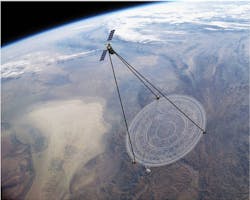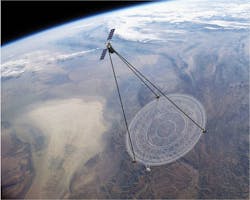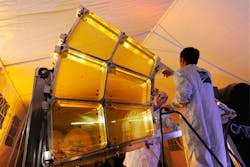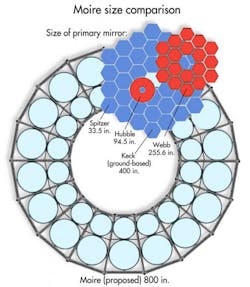Darpa explores membrane telescope for spying on Earth
Engineers at Ball Aerospace and Technologies Corp., Boulder, are developing a space-based telescope using lightweight membranes for optics instead of glass. The Darpa-funded device, dubbed the membrane optical imager for real-time exploration (Moire), would have one-seventh the weight of a traditional space telescope with the same power and resolution. This would make it possible to put the high-power telescope into a geostationary orbit 22,000 miles above the Earth where it could provide long-term surveillance of a specific area.
If deployed, the telescope would likely be used for spying, though it could also observe weather patterns and natural disasters. The space telescope would augment NSA, CIA, and other intelligence agencies that no longer have access to aircraft that can safely fly fast and high enough over denied territories to capture real-time imagery. It’s estimated a Moire telescope could cover 40% of the Earth’s surface at once, taking pictures of areas 6.2 x 6.2 miles with 3.2-ft resolution or generate real-time videos of the area at 1 fps.
The key to Moire is its replacement of heavy glass optics with lightweight polymer membranes, each etched with circular concentric grooves that turn the membrane into a Fresnel lens. Membranes would be approximately the thickness of a sheet of kitchen plastic wrap and held tautly in place by a metal framework.
The lenses would not reflect light like mirrors or refract it like traditional glass lenses. Instead, each membrane would diffract light, focusing it on an electronic sensor that would work with a processor to convert the incoming light into an image. The membranes aren’t as good at bending light as glass, but they are much lighter, letting engineers add more lenses to compensate for any inefficiencies.
The current plan is to launch a folded-up Moire into orbit where it would unfold and deploy an array of mirrors roughly 67 ft in diameter, which would make it the largest telescope optics ever made.
The program has been in its second and final phase since September 2011, having already demonstrated a working ground-based prototype. Engineers are now reducing risks in the program and will eventually do an on-orbit test of the imaging technology through the U.S.A.F. Academy’s FalconSAT-7 program.



